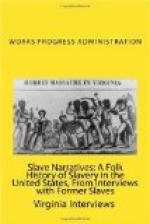Wide planks were used for the floors. The doors were hung on wooden hinges. The doors were never locked. They didn’t have any looks on them. You could bar them on the inside if you wanted to. They didn’t have no fear of burglars in them days. People wasn’t bad then as they is now. They had just one window and one door in the house. The chimney was built up like a ladder and clay and straw was stuffed in the framework.
I have seen such houses built right down here in Scott’s. My mother was a field hand. She lived in such a house in Tennessee. There wasn’t no brick about the house, not even in the chimney. In later years, they have covered up all those logs with weather boards and made the houses look like what they call “modern”, but theyr’e the same old log houses.
Food
My mother said her white folks fed her well. She had whatever they had. When she came to Arkansas, they issued rations, but she never was issued rations before. When they issued rations, they gave them so much food each week—so much corn meal, so much potatoes, so much cabbage, so much molasses, so much meat—mostly rubbish-like food. We went out in the garden and dug the potatoes and got the cabbage.
But in Tennessee, my mother got what ever she wanted whenever she wanted it. If she wanted salt, she went and got it. If she wanted meat, she went to the smokehouse and got it. Whatever she wanted, she went and got it, and they didn’t have no times for issuing out.
Social Affairs—Corn Shuckings, Quiltings and Dances
The biggest time I remember on the plantations was corn shucking time. Plenty of corn was brought in from the cribs and strowed along where everybody could get to it freely. Then they would all get corn and shuck it until near time to quit. The corn shucking was always at night, and only as much corn as they thought would be shucked was brought from the cribs. Just before they got through, they would begin to sing. Some of the songs were pitiful and sad. I can’t remember any of them, but I can remember that they were sad. One of them began like this:
“The speculator bought my wife and
child
And carried her clear away.”
When they got through shucking, they would hunt up the boss. He would run away and hide just before. If they found him, two big men would take him up on their shoulders and carry him all around the grounds while they sang. My mother told me that they used to do it that way in slave time.
Dances
They didn’t dance then like they do now all hugged up and indecent. In them days, they danced what you call square dances. They don’t do those dances now, they’re too decent. There were eight on a set. I used to dance those myself.




